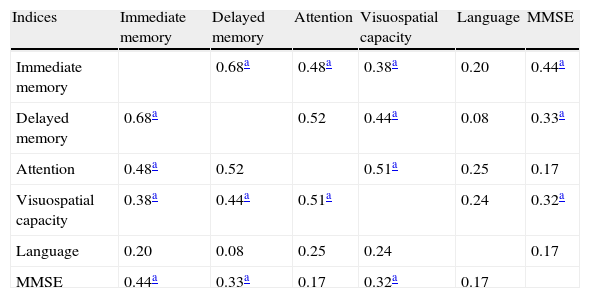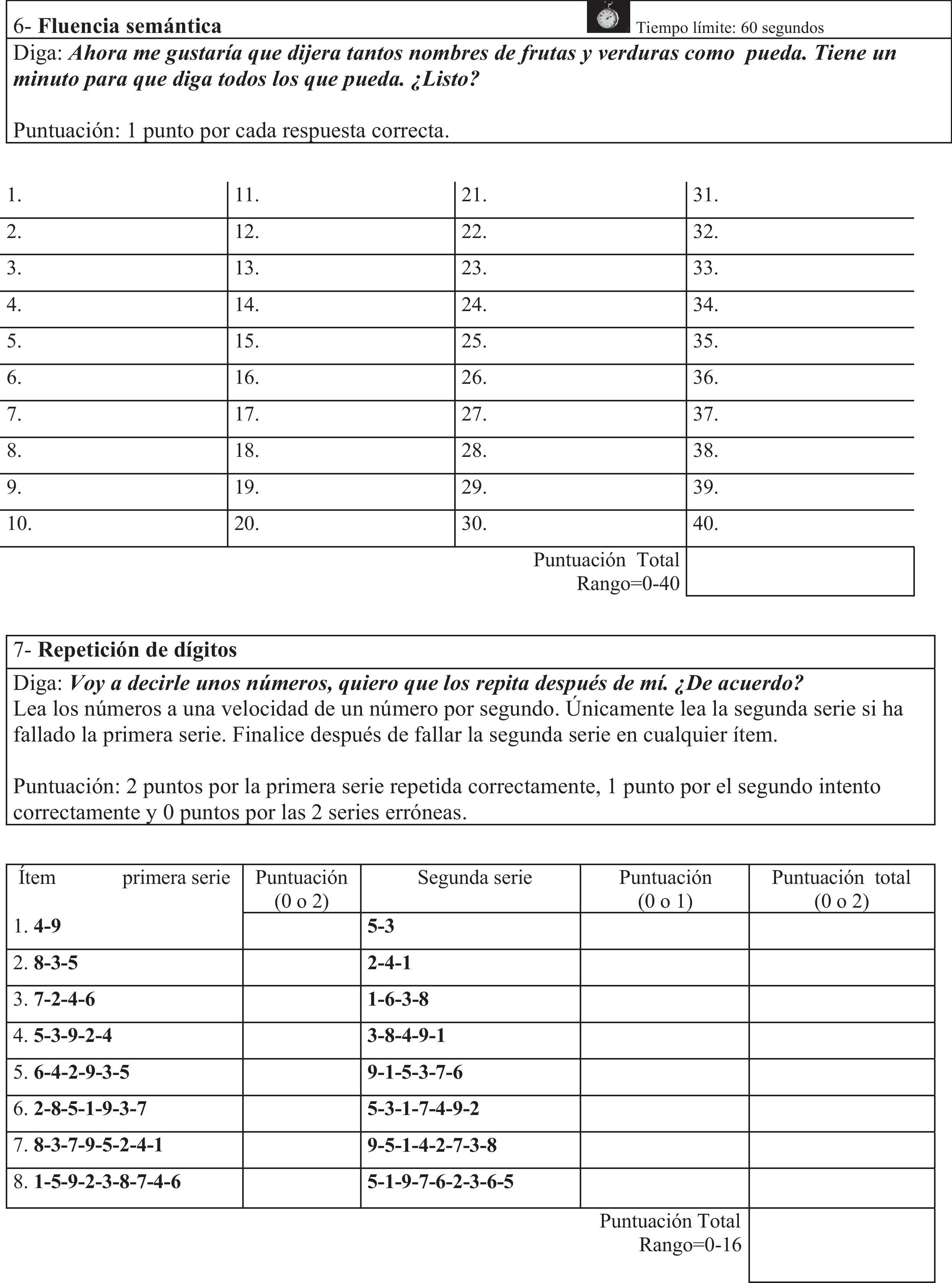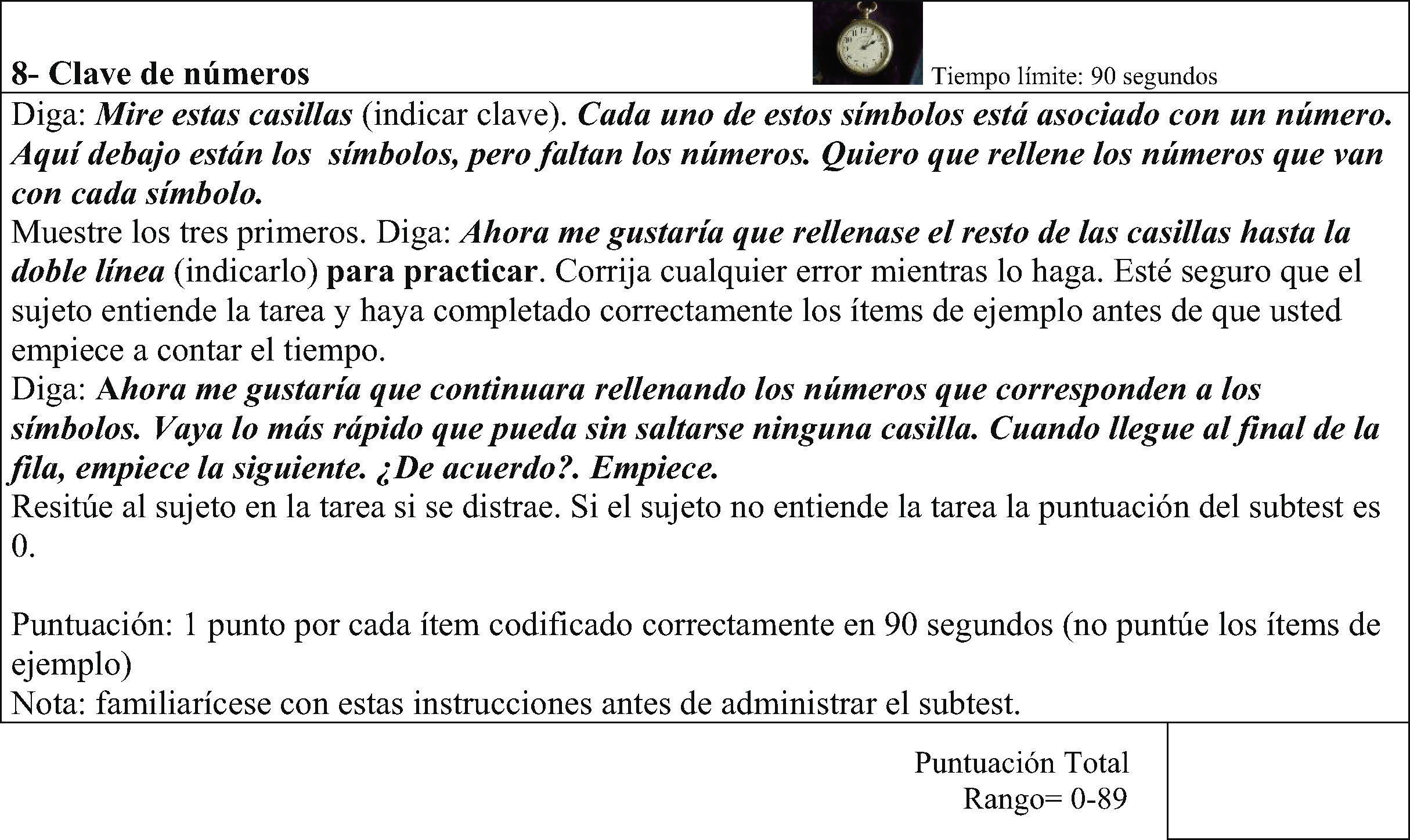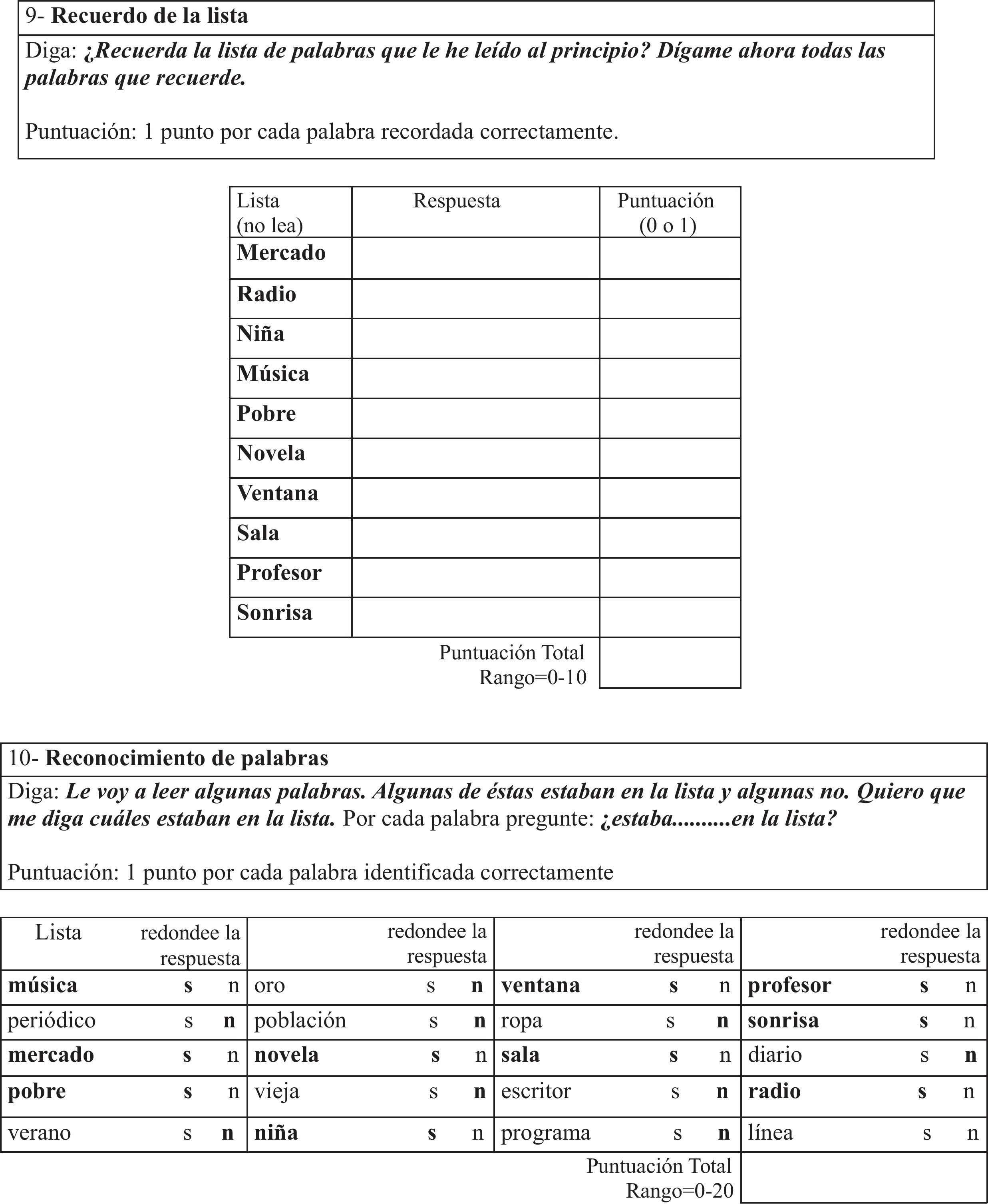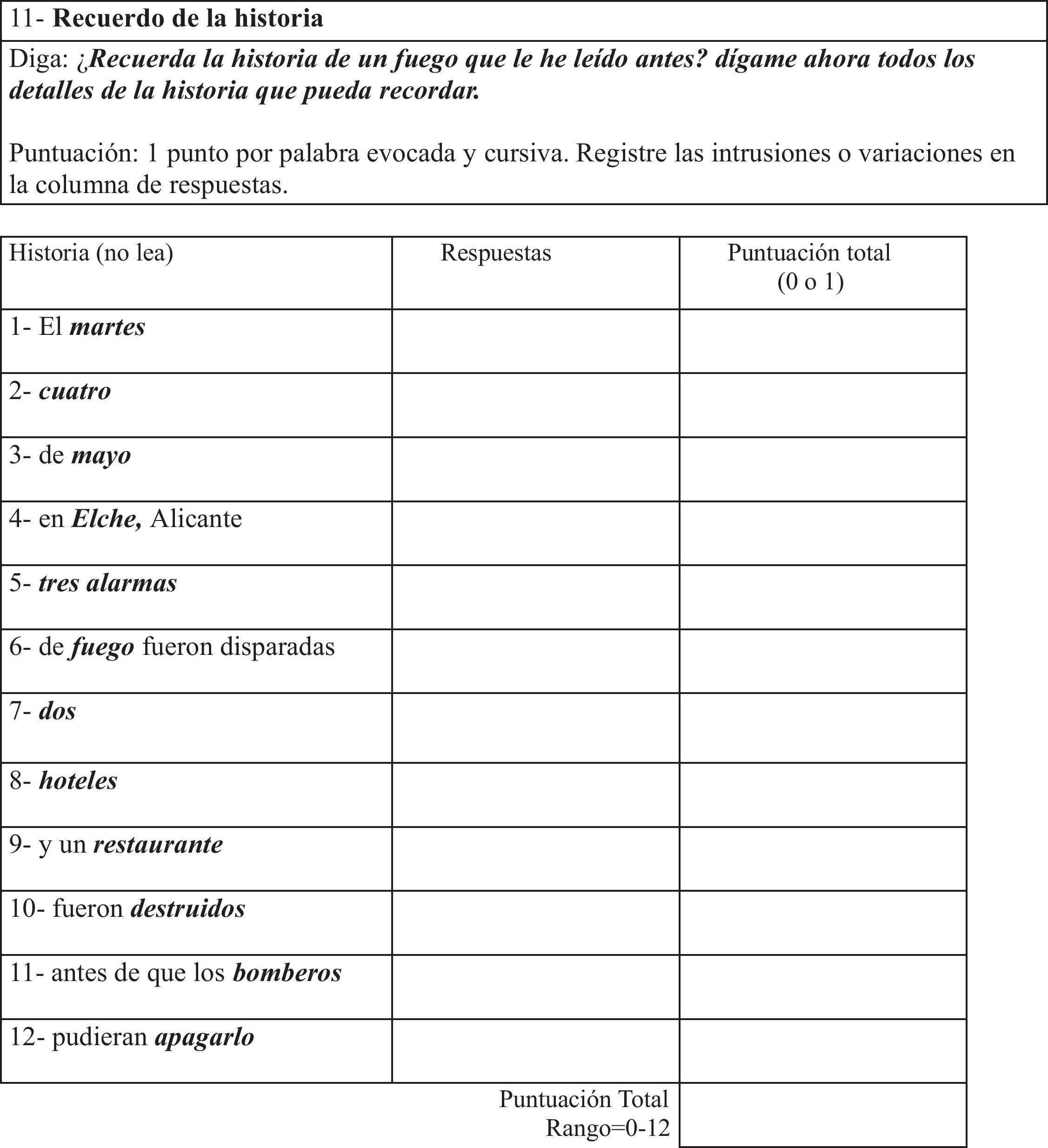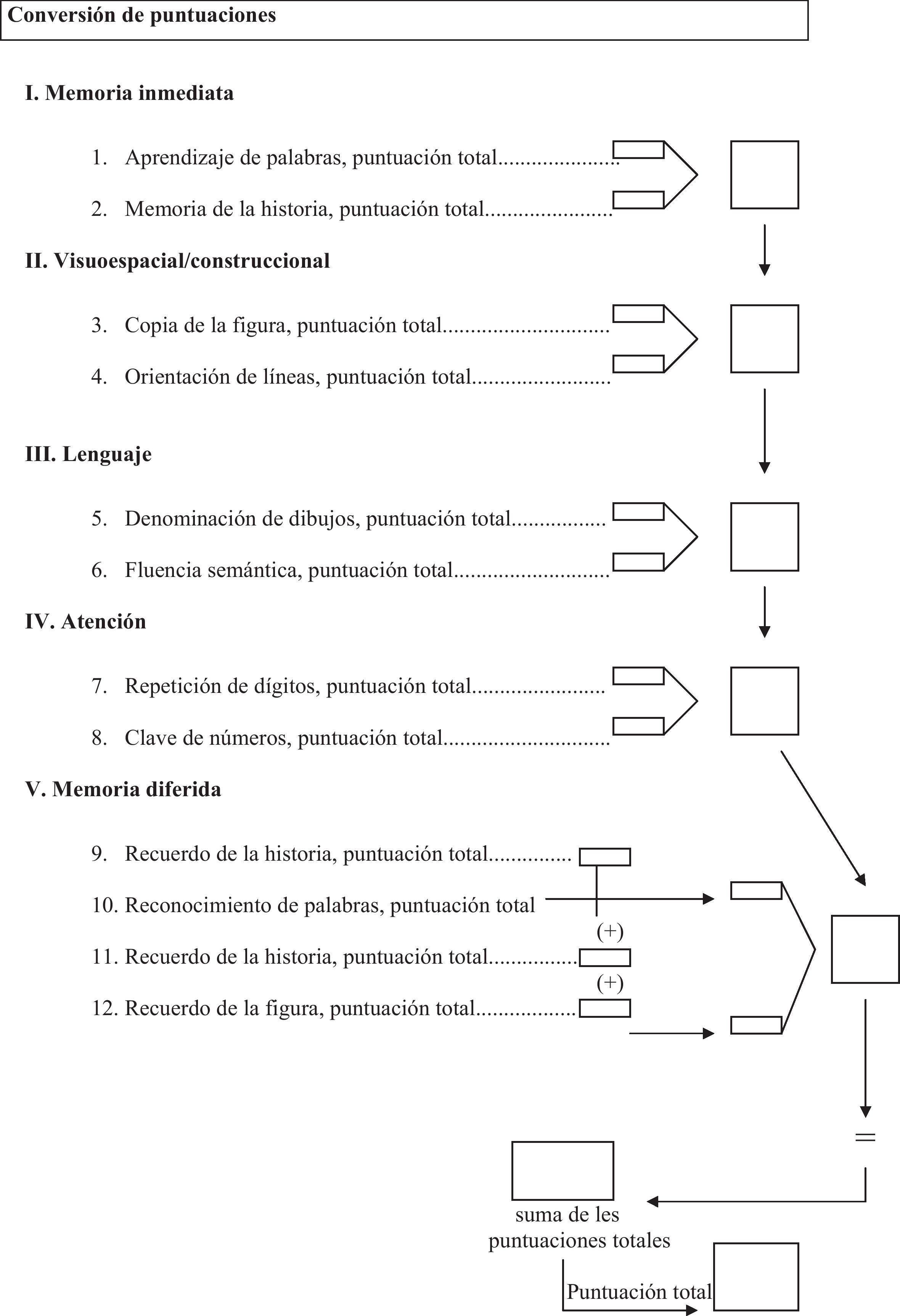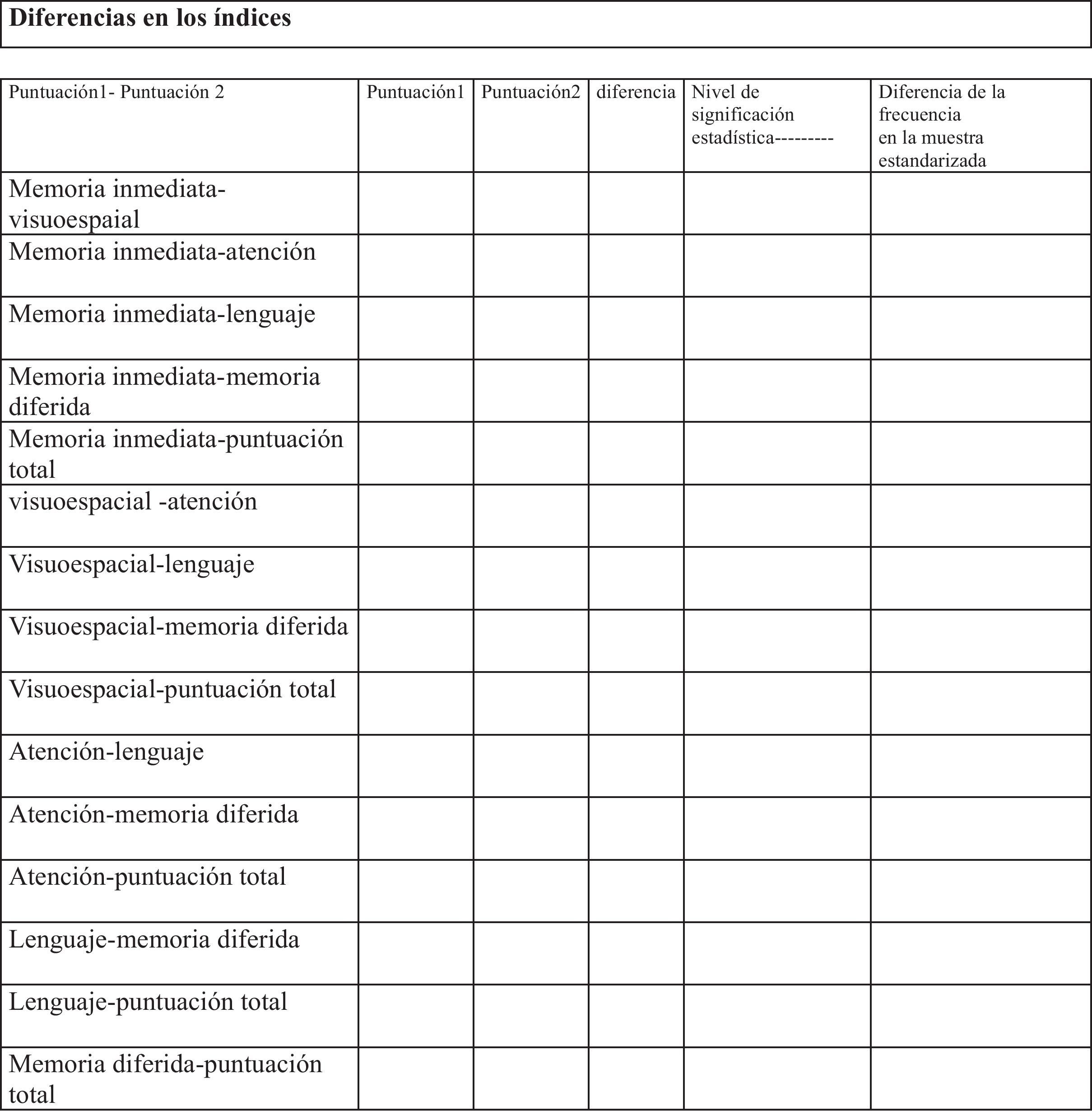RBANS is a short neuropsychological battery which has shown to be sensitive in detecting cognitive impairment in degenerative and non-degenerative diseases. It has been translated and adapted to different languages and is widely used in other countries, but no Spanish version has been published.
The objective was to make a valid translation of the RBANS to Spanish, and obtain a version adapted to the Spanish population.
Patients and methodsThe study included 73 subjects: 25 males with a mean age of 54 years and 9.72 years of education, and 48 females with a mean age of 53 years and 10.29 years of education. The battery was translated using the translation-back-translation method (with slight differences), followed by a descriptive pilot study in a sample of the normal population.
ResultsAn overall reliability coefficient with a Cronbach alpha of 0.73 was obtained in the translation and adaptation of the RBANS, form A (1998). Statistically significant positive correlations between the indices were obtained.
ConclusionsThe version translated and adapted to Spanish performs similarly to the original version.
La RBANS es una batería neuropsicológica breve que se ha mostrado sensible para la detección de trastorno cognitivo en patología degenerativa y no degenerativa. Ha sido traducida y adaptada a diversas lenguas y es ampliamente utilizada en otros países, pero no se ha publicado ninguna versión española.
El objetivo es realizar una traducción válida al español de la RBANS y obtener una versión adaptada a la población española.
Pacientes y métodosParticiparon 73 sujetos, 25 hombres, con una edad media de 54 años y escolaridad de 9,72, y 48 mujeres, con edad media de 53 y escolaridad 10,29. Se realizó una traducción mediante el método traducción-retrotraducción (con matices) y posteriormente se realizó un estudio descriptivo piloto en una muestra de población normal.
ResultadosEn la traducción y la adaptación de la batería neuropsicológica RBANS forma A (1998) se obtuvo un coeficiente de fiabilidad global con una alfa de Cronbach de 0,73. Se obtuvieron correlaciones positivas, estadísticamente significativas entre los índices.
ConclusionesLa versión traducida y adaptada al castellano se comporta de forma similar a la versión original.
It is widely accepted that researchers must have normative data that has been duly validated and culturally adapted in order to ensure that assessments of cognitive performance contain the lowest amount of contamination from other factors.1 This objective was clearly outlined for the Neuronorma Project, an extensive Spanish study that was published recently.2
Neuropsychological evaluation (NPE) for dementia may be more or less extensive and detailed depending on the complexity of the evaluation tools in use: brief scales, functional scales, simple test batteries, complex test batteries, and ideographic studies.3 The most recommendable method for performing NPE for dementia is to use a multidimensional test battery with psychometric properties including sensitive tests for each cognitive area.4 NPE is a key procedure in diagnosing, classifying, and monitoring the course of mild cognitive impairment, Alzheimer's disease, and other types of dementia.5,6 The RBANS battery7 is a multidimensional neuropsychological evaluation method that includes a series of different tests. Results from these tests establish performance patterns that characterise certain brain lesions or syndromes. This simple test battery is similar to some that are already in use in Spain, such as the Barcelona Test (Programa Integrado de Exploración Neuropsicológica-Test Barcelona).5 Other brief test batteries include the Mattis Dementia Rating Scale,8 the Cambridge Cognitive Examination included in the Cambridge Mental Disorders of the Elderly Examination,9 and other more specific tests for dementia, such as the Alzheimer's Disease Assessment Scale10 or the Consortium to Establish a Registry for Alzheimer's Disease.11 RBANS presents a number of advantages; it is quite brief compared to other test batteries, and provides 2 parallel evaluations (forms A and B) designed to eliminate the learning effect. Administration time is approximately 30minutes, and the battery is presented in a one-to-one setting by a neuropsychologist trained in administering the test.
It evaluates 5 cognitive functions through 12 subtests: attention (digit span and coding); language (image naming and semantic fluency); visuospatial/constructive ability (figure copy and line orientation tests); immediate memory (list learning and story memory); and delayed memory (list learning free recall, list learning recognition, story memory free recall, figure free recall). RBANS was designed for testing adults aged 20 to 89 years.
A preliminary validation study for the RBANS test battery12 made comparisons between 20 patients with probable Alzheimer-type dementia, 20 patients with Huntingdon's disease, and 40 control subjects. Tests revealed different cognitive profiles for each of the groups. RBANS was shown to be sensitive for the detection and classification of cases of dementia. Assessments of the sensitivity (discrimination capacity) and clinical utility of RBANS were based on data gathered from clinical groups with different neurological and psychiatric problems. The clinical group was composed of 138 patients with a diagnosis of AD, 49 with vascular dementia, 24 with mixed dementia, 15 with AIDS dementia complex, 19 with Huntington's disease, 33 with Parkinson's disease, 13 with depression, 59 with schizophrenia, and 31 with head trauma.
Since the late 1990s, a number of different studies on the utility and psychometric properties of the RBANS have been published.13–15 These studies contrasted findings in normal ageing16 with those from other diseases, including schizophrenia, other psychotic disorders, and dementia17 (Parkinson's disease18 or head injury19).
This test battery has been translated and adapted to other languages, including Japanese,20 Russian,21 and Hungarian,22 but no Spanish-language versions had been published.
The purpose of this study is to prepare a Spanish version of form A of the test battery and obtain other preliminary psychometric data from a Spanish population sample. Our aim was to gather a minimally representative sample containing subjects of different ages and educational backgrounds. It must be stated, however, that analysing sociodemographic influences falls outside the scope of this preliminary study.
Subjects and methodsA consecutive sample was recruited among the companions of patients referred to the dementia diagnosis and treatment unit at Hospital Universitari Mútua, Terrassa, by other care centres and volunteer associations serving the general population. The project was publicised by word of mouth. All participants were unpaid volunteers. All subjects were informed about the purpose of the study in terms they were able to understand, and they were asked to grant verbal consent. We recruited a total of 73 subjects meeting the following criteria:
Inclusion criteria: (a) residence in Spain; (b) acceptance of terms of participation by verbally providing informed consent; (c) age between 40 and 80 years; (d) basic reading and writing skills; (e) having sufficient hearing, sight, and physical fitness to complete the test; (f) score on the MMSE equal to or higher than 24; and (g) having a good functional state according to normality criteria on the Blessed Dementia Rating Scale (BDRS).24
Exclusion criteria: (a) any type of CNS condition affecting cognition and/or functional abilities; (b) history of CNS infections (meningitis, encephalitis, etc.); (c) lack of any present or past history of severe psychiatric illness according to DSM-IV criteria; (d) clinically significant hypothyroidism; (e) known metabolic changes; (f) history or presence of alcohol or other drug abuse in the preceding 24 months, and (g) presence of any factor that rendered the subject's participation inappropriate according to the lead researcher's judgement.
We generated a satisfactory Spanish translation equivalent to the original version by using the different steps in the forward-translation/back-translation method, together with qualitative methodology25,26 in discussion groups to lend nuances to the list learning and list learning recognition subtests.
We first obtained 2 translations from English to Spanish prepared independently by translators (bilingual native Spanish speakers) with no prior knowledge of the RBANS test battery. The research team, composed of neuropsychologists, then compared the 2 translations to obtain the first consensus version. Subsequently, 2 researchers from outside the research team evaluated the first version and provided suggestions for improving its conceptual equivalence and expression. Questionable items were then identified and alternative wordings were proposed. The team reworded certain items to minimise any differences between the translated version and the original.
The research team evaluated any items and responses having questionable conceptual equivalence or being expressed in an unnatural or incorrect way and made the appropriate changes to create the second consensus version. A native English-speaking translator then used that version to prepare the back-translation from Spanish to English. We then compared the back-translation to the original version as a committee to detect any potential semantic changes. This resulted in the pilot version of the test. We then tested the pilot version to check the viability of the test battery. These steps produced the definitive Spanish-language version.
Only the testing instructions and scoring criteria were translated to produce the adapted versions of non-verbal subtests. The shape of the geometrical figure, the line orientation, and the number code all corresponded to those in the original version.
For verbal tests such as the list learning and list learning recognition subtests, we were mindful of factors such as word frequency, imagery, phonemic and semantic similarity, and word length.13 In some cases, it was impossible to meet all equivalence criteria and we focused primarily on frequency and imagery, as the research team's review of the literature revealed that these considerations usually took priority over others.14–16 Psycholinguistic criteria were therefore held to be more important than semantic equivalence. The story memory subtest contained a logical problem described as taking place in Cleveland on the original test. When determining an equivalent for the adapted version, we searched for a Spanish city with the same size ratio compared to Madrid as Cleveland has compared to Washington, D.C.
All participants were evaluated in a single session in which the Spanish version of the RBANS test battery was administered alongside the MMSE, an internationally-recognised cognitive screening test.23 Functional state was evaluated using the BDRS.24
We used SPSS software version 11.0 for Windows for data analysis and performed a descriptive study of the test variables. Correlations between the indices of different scales were determined using the parametric Pearson correlation. P<.01 was considered to be statistically significant. The reliability analysis was performed using an internal consistency analysis with Cronbach's alpha index.
ResultsThe Spanish translation of the RBANS test battery was created following the method outlined above. That translation is provided as Annex 1.
For information purposes only, Tables 1 and 2 provide descriptive sociodemographic data for the sample; these data reveal a predominance of women, who account for 66% of the participants. Regarding age and educational level, most participants were either in the 50 to 59 age group (with average to high educational levels) or in the 70 to 79 age group (with similar educational levels); this difference was not statistically significant. All the different age groups and educational levels included in our study were represented, even if representation was minimal.
Cronbach alpha provided an overall reliability coefficient of 0.73 for the translated and adapted version of the RBANS neuropsychological test battery.
While all of the correlations were statistically significant (see Table 3), the most consistently obtained correlations (P>.01) were between immediate memory and 3 other indices: delayed memory (0.68), attention (0.48) and visuospatial capacity (0.38). There were also consistent correlations between visuospatial capacity and 2 other indices: attention (0.51) and delayed memory (0.44).
Pearson's correlation between different indices in the test battery and with the MMSE.
| Indices | Immediate memory | Delayed memory | Attention | Visuospatial capacity | Language | MMSE |
| Immediate memory | 0.68a | 0.48a | 0.38a | 0.20 | 0.44a | |
| Delayed memory | 0.68a | 0.52 | 0.44a | 0.08 | 0.33a | |
| Attention | 0.48a | 0.52 | 0.51a | 0.25 | 0.17 | |
| Visuospatial capacity | 0.38a | 0.44a | 0.51a | 0.24 | 0.32a | |
| Language | 0.20 | 0.08 | 0.25 | 0.24 | 0.17 | |
| MMSE | 0.44a | 0.33a | 0.17 | 0.32a | 0.17 |
For a level of P<.05, language was correlated with all other indices, as were attention and delayed memory.
In turn, we also found a statistically significant correlation (P<.01) between the MMSE and the following indices: immediate memory (0.44), delayed memory (0.33), and visuospatial capacity (0.32). For all other indices, correlations were significant for a limit of 0.05 (Table 3).
DiscussionFirstly, we will address the nuances of the translation. Literal translation of a neuropsychological evaluation tool is out of the question, since the tool must reflect cultural peculiarities, as stated above.1,2 Terms and sometimes even concepts have therefore had to be modified; semantic categories have also been changed according to psycholinguistic criteria, such as the term's frequency of use and its imagery.
One of the limitations of the test is that since it is a brief test battery, it is unable to evaluate all of the cognitive functions that may be altered in patients with focal or diffuse brain injury. We therefore face the well-known dilemma of having to choose between a test of a viable length and a test that is exhaustive. Depending on the patient being assessed, the neuropsychologist will have to recur to the versatility of NPE3 in order to evaluate functions that are not considered by the test battery, such as people recognition and orientation in place and time, sensory perception, ideomotor praxis, and the executive functions. The latter can only be measured using the semantic fluency subtest.
The test shows good reliability, that is, accuracy in measuring the variables it purports to measure, as shown by the internal consistency analysis. With a Cronbach alpha of 0.73, the Spanish adaptation of the RBANS is adequate.
Statistically significant positive correlations are present between all of the subtests on the Spanish version, and correlations are similar to those in the original. For example, the indices for immediate memory and delayed memory show a correlation of 0.63 in the Spanish version and 0.68 in the original. Likewise, we found that correlations between indices for the Spanish version and the original were very similar between immediate memory and visuospatial capacity (0.38; original, 0.28) or attention (0.48; original, 0.40); and between visuospatial capacity and attention (0.51; original, 0.32) or delayed memory (0.44; original 0.35). Where differences can be observed, the Spanish version shows a greater degree of correlation. This is indicative of covariation between different indices.
Based on these results, we maintain that this Spanish-language adaptation of the RBANS test battery shows acceptable psychometric properties with overall internal consistency and significant positive correlations. It may therefore be considered a useful tool for assessing cognitive state in the Spanish population.
It must be said that this is a preliminary study designed to produce a Spanish-language translation and adaptation of the RBANS. At present, we are completing an expanded normalisation study on this tool and normalising data in adults older than 40. This study will provide an analysis of the influence of different sociodemographic variables and others. We also believe that it would be a positive step to obtain validation data by studying test results from subjects with varying degrees of cognitive impairment.
Conflicts of interestThe authors have no conflicts of interest to declare.
We would like to thank Dr Adolf Tobeña Pallarés of the doctoral programme in psychiatry at the Autonomous University of Barcelona for reviewing our study, and Noemí Cerulla, Noemí Calzado, Roser Clapés and Mònica González for recruiting our population sample.
Dr Manuel de Gracia of the University of Girona performed the statistical analysis.
Please cite this article as: Muntal Encinas, et al. Traducción y adaptación española de la batería neuropsicológica Repeat table Battery for the Assessment of Neuropsychological Status (RBANS) forma A en una muestra piloto. Neurología 2012;27:531–46.






